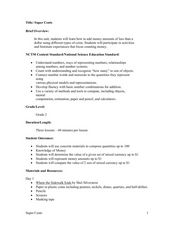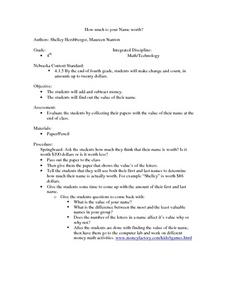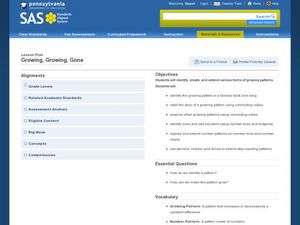Curated OER
Super Cents
Second graders study money amounts less than a dollar. In this math instructional activity, 2nd graders practice counting coins. Students read various stories and discuss how money was used in the stories.
Curated OER
What Can I Buy?
In this counting coins review worksheet, students examine 4 price tags in order to record the number of nickels and dimes needed to buy the item. Students also respond to 1 short answer question.
Curated OER
Trading Game
Pupils listen to story about money or coins, and play game to help them solidify their understanding of money. Students focus specifically on coin value and calculating amounts of money up to fifty cents or above, depending on level.
Curated OER
Create and Solve
In this early childhood math practice worksheet, students use problem solving skills to solve 6 story problems that require them to count coins.
Curated OER
How Much More?
In this counting coins worksheet, learners color the coins that match the given money amount for each child. Students then color the coins each child will use, but color the fewest number of coins possible.
Curated OER
Making $ents
Second graders complete several activities that give them opportunities to practice and model strategies that help them count money. They read The Penny Pot storybook; they play a trading game with various coins. They participate in a...
Curated OER
Cool Cookie Math
Second graders identify the value of coins and make change from a dollar using different amounts. They are given story problems and use a fake shop in which they can buy things in which they have to determine how much change they would...
Curated OER
How Much is Your Name Worth?
Students identify the value of each coin type and then use a code to assign each letter of the alphabet to the value of the coins. They add coin combinations to determine the value of their name.
Curated OER
Bank Tellers and Math
Second graders learn what math skills bank tellers need to do their jobs correctly.
Curated OER
Count Coins and Bills
Students study the names and values of different denominations of paper money, count sets of money that include both coins and bills. They complete a money chart, read and solve word problems.
Curated OER
Match the Picture of Money to the Correct Word Worksheet
In this money pictures and words worksheet, student fill in the blanks below 5 money pictures with the words that name them. They see the words in a word bank below the pictures. They see words which include penny, nickel, dime, and dollar.
Curated OER
Counting Money
Students read, write, and identify different coin combinations and use this information in real-world situations.
Curated OER
Coin Values
In this coins activity, students find the values of coins and the totals of all the values added up together. Students complete 6 problems.
Curated OER
Most Likely/Least Likely
Learners consider a practice problem which prompts them to choose the type of marble most likely to be picked out of a group. Then, they answer probability-type questions regarding a spinner, and a tally chart of coins.
Curated OER
Making "Cents"
In this counting coins activity, learners use the table for coin values to solve the 4 money counting questions. Students enhance their coin counting skills.
Curated OER
Coin Cards
In this U.S. coins worksheet, students cut apart 16 cards that feature photographs of the front and back of quarters, nickels, dimes and pennies. There are no directions.
Curated OER
Coin Combos
In this combination of coins worksheet, students make the specified amount using the number of coins indicated. Example: Make 35 cents with 2 coins. (1 quarter, 1 dime).
Curated OER
Learn to Earn When You Tend to Spend
Students examine spending and earning, and calculate change up to a dollar. They view and participate in demonstrations of earning and spending math problems, complete a worksheet, and play a game in pairs that simulates banking.
Curated OER
Growing, Growing, Gone
Budding mathematicians identify growing patterns in numbers and songs then create their own patterns. They look at number patterns and language patterns and then create their own using money and footprints.
Curated OER
The Price is Right, So Let's Make Change
Students estimate, calculate, and count back the amount of change needed from purchases made during small group activities.
Curated OER
How Many of Each Coin Do We Have in Our Bag?-- Class Bar Graph
In this math learning exercise, students participate in a group project to record the kind of coins they pick at random from a bag. Students record the data on this classroom bar graph.
Curated OER
Change Mixer
Students use their abilities to recognize coins and their values in this game that focuses on locomotor skills (skip, slide, gallop, run, jump). This game also requires students to add coin values.
Curated OER
Matching Pairs
Learners take turns matching the appropriate shapes (listing coin values) to those with numerical values listed on them. When students are successful, they win a blank shape for their collection.
Curated OER
Seeing Numbers In Tens And Ones
Second graders develop the skill of place values up to the tens place. They practice identifying the values of 2 digit numbers and writing the correlating values with counting. They use the example of money to make the lesson more...

























